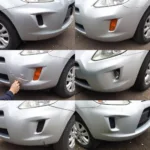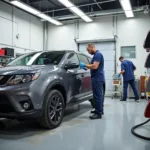Scuffs on your car paint can be an unsightly nuisance. Whether from a rogue shopping cart, a careless driver in a parking lot, or even just brushing against a wall, these superficial blemishes can detract from your car’s appearance. Fortunately, repairing minor scuffs on car paint is often a DIY project that can save you time and money. This guide will walk you through the process of identifying, assessing, and fixing those annoying scuffs, restoring your car’s finish to its former glory.
Identifying the Type of Scuff
Before you begin the repair process, it’s crucial to identify the type of scuff you’re dealing with. This will determine the best course of action. Generally, car paint scuffs fall into two categories: clear coat scuffs and paint scuffs. Clear coat scuffs only affect the top protective layer, while paint scuffs go deeper, exposing the base coat. A simple way to tell the difference is to run your fingernail gently across the scuff. If your nail catches, it’s likely a paint scuff. If it glides smoothly, it’s probably just a clear coat scuff.
Gathering Your Supplies
Once you’ve identified the scuff, gather your supplies. For clear coat scuffs, you’ll need car wash soap, microfiber towels, rubbing compound, polishing compound, and car wax. For deeper paint scuffs, you’ll also need primer, touch-up paint, and clear coat. You can find these supplies at most auto parts stores.
Having the right tools can make a significant difference in the quality of the repair. Invest in high-quality microfiber towels to prevent further scratching. Applicator pads are also helpful for applying compounds and wax.
How to Repair Clear Coat Scuffs
Start by thoroughly washing the affected area with car wash soap and water, then dry it completely with a microfiber towel. Next, apply a small amount of rubbing compound to a clean microfiber towel or applicator pad. Rub the compound onto the scuff using gentle, circular motions. This will remove the damaged clear coat and smooth the surface. After the rubbing compound, apply polishing compound in the same manner. This will further refine the finish and remove any swirl marks left by the rubbing compound. Finally, apply a layer of car wax to protect the repaired area and restore shine.
How to Repair Paint Scuffs
Repairing paint scuffs is a bit more involved. After washing and drying the area, you may need to lightly sand the scuff with fine-grit sandpaper to create a smooth surface for the primer. If you need to repair scratches in paint on car, consider professional services. Next, apply a thin layer of primer to the exposed metal or plastic. Once the primer dries, apply several thin coats of touch-up paint, allowing each coat to dry before applying the next. Finally, apply a few coats of clear coat to seal and protect the repair. For car paint repair mobile service or if you are in specific areas like Reigate or Southampton, mobile services can offer convenient solutions.
When to Seek Professional Help
While many minor scuffs can be repaired at home, some deeper or more extensive damage may require professional attention. If the scuff is very deep, has exposed bare metal, or if you’re unsure about tackling the repair yourself, it’s always best to consult a professional. They can expertly assess the damage and recommend the best course of action. You can even find options for repair paint scuffs car from professional services.
Conclusion
Repairing scuffs on your car paint can be a straightforward process, especially if you catch the damage early. By following these steps and using the right techniques, you can restore your car’s finish and protect it from further damage. Remember to correctly identify the type of scuff you’re dealing with and choose the appropriate repair method. How to repair scuffs on car paint may seem daunting, but with the right information, it can be a manageable task.
FAQ
-
Can I use toothpaste to repair car paint scuffs? While toothpaste is sometimes suggested as a quick fix, it’s not a recommended solution for car paint repair. It can be abrasive and may cause more harm than good.
-
How long does it take for touch-up paint to dry? Drying time varies depending on the type of paint and the ambient temperature. Always refer to the manufacturer’s instructions for specific drying times.
-
What if the scuff is on a plastic bumper? The repair process is similar for plastic bumpers, but you may need to use a plastic primer and adhesion promoter for optimal results.
-
How can I prevent car paint scuffs? Careful parking, avoiding tight spaces, and using protective films can help prevent scuffs.
-
Can I wax my car after repairing a scuff? Yes, waxing is recommended after the repair is complete and the paint has fully cured. This will protect the repaired area and restore shine.
-
What if I can’t match the touch-up paint perfectly? Slight color variations can be minimized by blending the paint edges. If you’re unsure, consult a professional for color matching.
-
Where can I find mobile car paint repair near me? Searching online for “mobile car paint repair” along with your location (e.g., “mobile car paint repair southampton”) will yield local results.
Need more assistance? Contact us via WhatsApp: +1(641)206-8880, or Email: [email protected]. Our customer service team is available 24/7.


